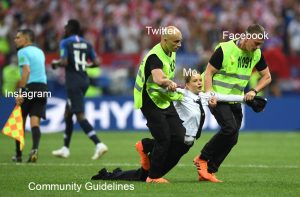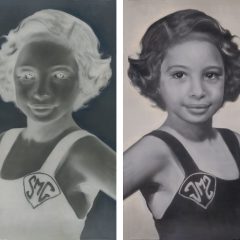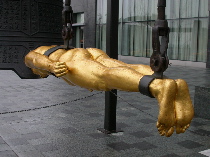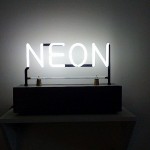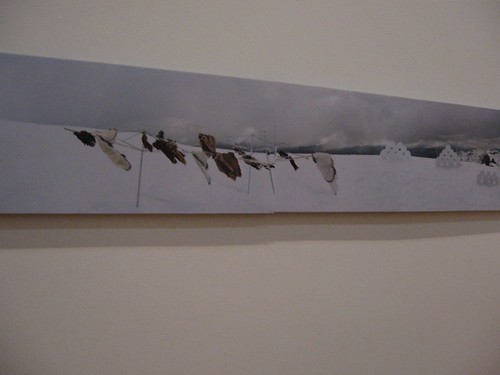
Anthony Goicolea, detail of Snowscape, photocollage, Postmasters Gallery
Over the river and through the New York and Massachussetts woods, it’s hard to imagine that that the planet we love is becoming hell on Earth. So I arrived at MASS MoCA refreshed and optimistic. The ride was spectacular. Hey, everyone loves a landscape.
But when it comes to contemporary landscapes, we’re seeing a whole different picture. And that’s what the museum’s summer exhibit, Badlands, is all about–what’s different in landscapes today.
There is a lot to enjoy in this show–many concept-driven works that reinvent landscape forms, materials, or at least intent.
The biggest challenge it seems to me is finding the contemporary in what passes for traditional landscapes, be they photographed or painted. I found it most clearly in Anthony Goicolea’s photo-collages and in Melissa Brown’s paintings.
Goicolea’s long (24 feet!!!), scroll-like photograph of a snowy landscape, with clothes hanging on a line and other signs of a human community, narrates a survivalist theme in the long story of our place on the planet. That same theme plays out in his Tree Dwellers, a tribe of rough characters who have made a tree into their village, an image that is as Medieval as it is contemporary. Here’s a link to a piece of Goicolea’s that Roberta and I both admired at the Armory Art Fair in New York.
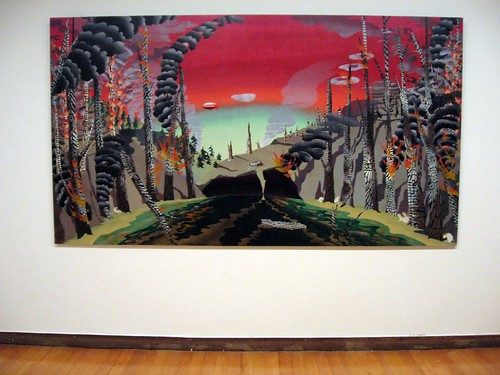
Also outstanding were three paintings by Brown, each depicting some sort of natural disaster in cheery colors and decorative, storybook forms. In Forest Fire, Brown seduces with a red sunset, before displaying the more subdued, devastated forest. The smoke poses as pine cone-shaped clouds, before revealing its true nature.
In a video that takes landscape-as-an-idea a step further, Marine Hugonnier’s Ariana, remains an outstanding example. This surrealistic travelog/exploration of landscape as shaped by history, military strategy, politics and ideas was in the Philadelphia Art Museum’s series of international videos last year(post here).
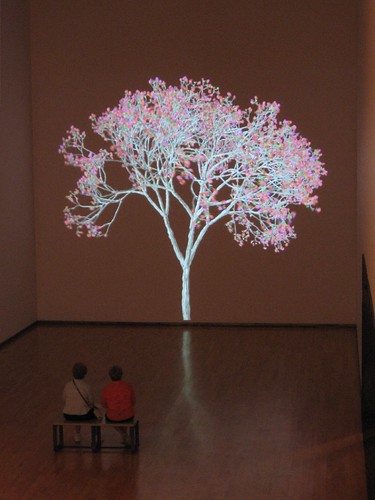
Jennifer Steinkamp, Mike Kelley, 2007, multimedia installation, courtesy Lehmann Maupin Gallery
Another familiar piece I was happy to see again–Jennifer Steinkamp’s fluttering Mike Kelley going through its digital paces, marking off the seasons. If this isn’t a landscape of the mind, I don’t know what is. (Here’s a link to our Look! It’s Libby and Roberta episode with this piece in action at Locks Gallery).
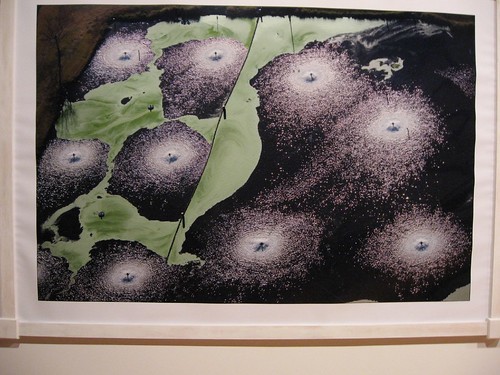
Henry J. Fair, Dividing Line, Aeration Tanks at Sugar Mill, Gramercy, LA, 2005, c-print
Other things I especially liked–Henry J. Fair’s literal, overhead photographs of eco-disasters, not surprising but quite beautiful and mysterious; Joseph Smolinski’s plans and models for wind turbines disguised as trees (think cell phone towers fashioned as trees); and Mary Temple’s Northeast Corner, Southwest Light, which mimics shadows cast by a window and outdoor vegetation. But there’s no real window, no shadows. This piece, which suggests daylight and space that don’t exist doesn’t look like much at first. But then its weaves its spell and tips its hand all at once.
In all these pieces, the threat man poses and imposes on the landscape is the thread that carries through. It’s a concept that trumps any other shifts and maneuvers because it bears the burden of urgency; and it can turn even straightforward witnessing of the disaster around us into something contemporary and relevant.
Others in the show are Center for Land Use Interpretation, Yutaka Sone, Alexis Rockman, Leila Daw, Mike Glier, Robert Adams, Ed Ruscha, Boyle Family, Paul Jacobsen, Jane D. Marsching and Terreform, Gregory Euclide, Vaughn Bell, and Nina Katchadourian (whose sculptural landscape intervention, placing a branch with autumn leaves on a live maple, seemed oddly conventional and old-fashioned in its concerns).
The other big show at MASS MoCA, Eastern Standard, has an Olympics tie-in, with Western artists looking at China. I found the show chock full of interesting observations.
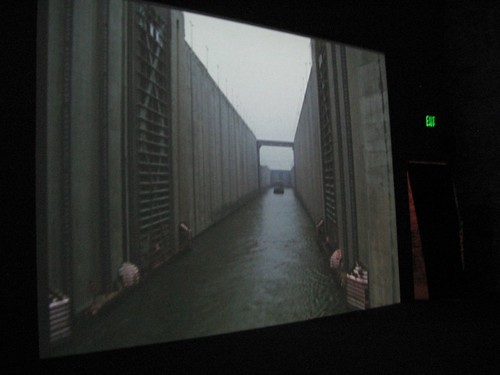
Catherine Yass, Lock, two simultaneous projections of 16mm film, 9 minutes 44 seconds, Galerie Lelong
I think my favorite piece was Catherine Yass’ Lock, a film of old-fashioned looking boats going through the ultra-industrial giant locks of the Three Gorges Dam. The boats and people are small, the locks are huge, and the strip of light coming through the closing gates looks like a Barnett Newman zip.
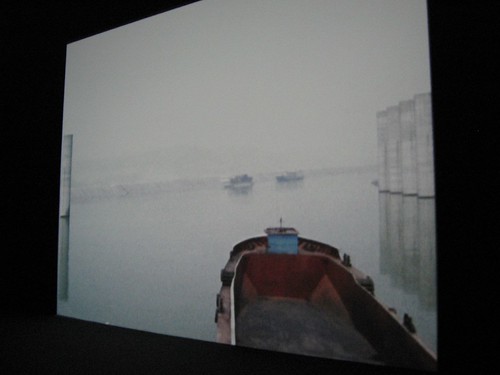
Catherine Yass, Lock, two simultaneous projections of 16mm film, 9 minutes 44 seconds, Galerie Lelong
When the boats emerge onto the river from the modern engineering marvel, they seem to be entering a foggy Chinese waterscape of 200 years prior.
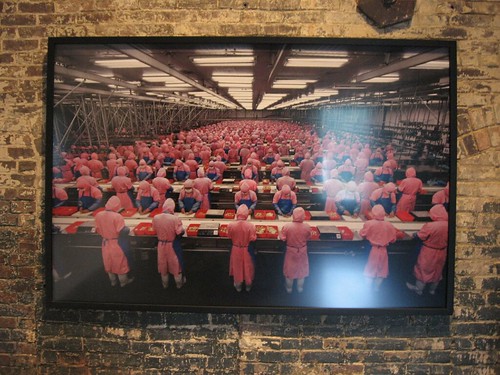
Edward Burtynsky, Manufacturing #17, Deda Chicken Processing Plant, Dehui City, Jilin Province, 2005, chromogenic print, Robert Koch Gallery
I also fell in love with photographs by Edward Burtynsky, from his Manufacturing series, of Chinese workers in uniforms. Like a Vija Celmins seascape or skyscape, he implies that more of the same exists beyond the edge of the camera’s eye, thereby capturing the vastness and the mania of the Chinese commitment to uniformity.
There was lots to see in this show that I enjoyed. The show includes work by Roma Pas, Lucy Raven, Oliver Lyons and Alexis Raskin, Sarah Beddington, Tobias Bernstrup, Patty Chang and David Kelley, David Cotterrell, Jules de Balincourt, Annika Larsson, Walter McConnell, David Thomas, and Michael Wolf.
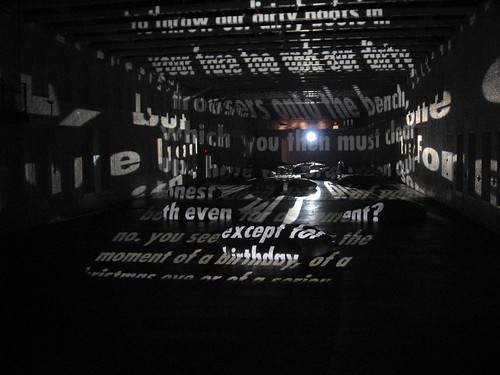
Jenny Holzer, PROJECTIONS, room installation
Other things of interest included a Jenny Holzer room installation. Holzer’s words may have lost their way some of the time, but visually, this was fantastic. An exhibit of works by Anselm Kiefer round things out and make a nice pairing with Badlands.


